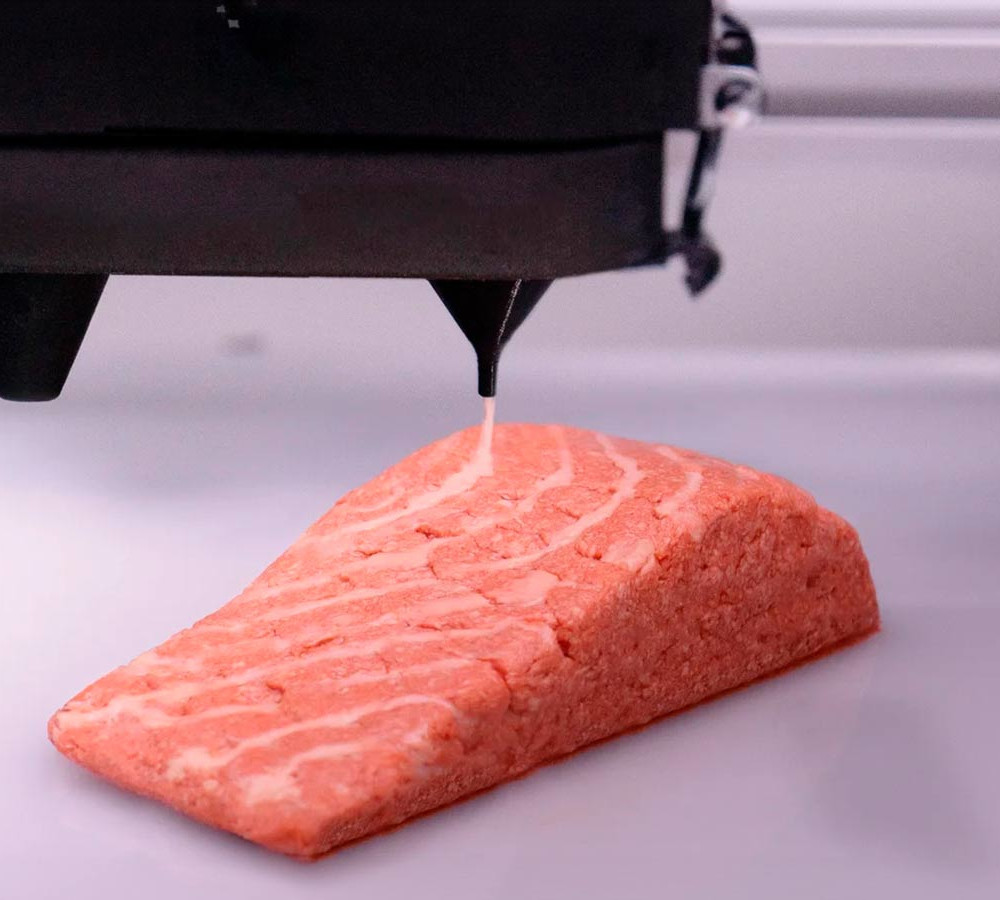3D-Printed Salmon Fillet Paves the Way for Meat and Fish Printing

There have been studies indicating a potential collapse of fishing grounds by 2050. It is projected that by the same year, the amount of plastic in the sea may surpass the fish population. However, the concerning reality is already apparent: around 80% of fishing grounds have hit their exploitation limit or are overexploited. Aquaculture presents its own challenges as fish protein is utilized for fish farm feed. Given this grim outlook, breakthroughs in science and technology are imperative to present dietary alternatives.
Similar to discussions around lab-grown meat, meat, and fish printers are gaining traction as a potential solution to nourish our population in the upcoming decades. For instance, a notable development is the recent commercialization of a 3D-printed salmon fillet.
A fish printer for the menu of the future
Before moving forward, it’s important to clarify that the new salmon-like preparation isn’t derived from actual fish but is crafted using mycoproteins sourced from fungal filaments, providing it with a meaty texture. We’ve previously discussed the diverse applications of fungi and their mycelium, ranging from construction and furniture manufacturing to pollution-fighting tiles on building exteriors. However, their utilization in food printing is a relatively recent development.
The Austrian company responsible for the vegan salmon fillet asserts that, in addition to mushroom filaments, they’ve incorporated twelve other ingredients, including pea protein, plant oils, and algae extracts. The outcome is a protein and Omega-3-rich food akin to its genuine fish counterpart. A notable advantage of this 3D-printed fillet is its longevity, remaining fresh for up to three weeks.
While we often discuss prototypes and emerging technologies in testing phases, the recently unveiled 3D-printed “salmon-inspired” fillet is now commercially available in Europe. Its creators contend that this food technology is ready for industrial production and will represent the vanguard of various foods born from 3D printers in a future characterized by population growth and resource limitations.

While we often discuss prototypes and emerging technologies in testing phases, the recently unveiled 3D-printed “salmon-inspired” steak is now commercially available in Europe. Its creators contend that this food technology is ready for industrial production and will represent the vanguard of various foods born from 3D printers in a future characterized by population growth and resource limitations.
3D-printed calamari rings
Vegan meat and fish printing technology is incredibly versatile, expanding its horizons beyond salmon fillets to include experiments with shrimp and calamari rings. One such pioneering effort is led by a team of researchers in Singapore, who’ve harnessed green soy and microalgae proteins to replicate the texture, flavor, and elasticity of cephalopod rings.
The inaugural rendition of the 3D-printed squid rings was unveiled in August 2023 during a gathering of the American Chemical Society. Employing a food 3D printer, this innovative system relies on edible inks capable of mimicking various textures, be they greasy or fibrous. The distinct marine flavor is attributed to the microalgae used, offering both umami and a maritime aftertaste.
While a battered version of the squid rings has not been unveiled yet, the researchers have successfully passed the culinary test by frying their creation in an air fryer. Their ongoing mission is to enhance the elasticity and texture of their vegan squid before it hits the commercial market. You can observe a portion of their process in the following video:
@hashem.alghaili Scientists created 3D-printed calamari. #Research #Food #Biotechnology ♬ original sound – Hashem Al-Ghaili
It’s important to note that meat and fish printing isn’t inherently sustainable; its ecological footprint largely hinges on the choice of raw materials. In the case of squid rings, the green soybeans used are sourced from Asian food industry waste, as the vegetable’s starch is typically utilized in crystal noodles. For those interested in exploring alternative food solutions driven by cutting-edge technologies, we recommend reading this article on synthetic proteins crafted from water, electricity, and air.
Source:

